List of Parliamentary constituencies in Cleveland
Cleveland, England was abolished in 1996 both as a county council and a ceremonial county, but the name Cleveland continues to be used unofficially in subsequent boundary reviews as presented by the Boundary Commission for England to describe the area covered by the former county for the purpose of the rules which strongly deter cross-council constituencies (spanning more than one local authority within its area). The area covers the unitary authorities of Hartlepool, Middlesbrough, Redcar and Cleveland, and Stockton-on-Tees. The constituency boundaries used up to the 2005 United Kingdom general election were drawn up when it was a county. The area is divided into 6 Parliamentary constituencies – 5 Borough constituencies and 1 County constituency.
Constituencies
† Conservative ‡ Labour ¤ Liberal Democrat UKIP
| Constituency[nb 1] | Electorate[1] | Majority[2][nb 2] | Member of Parliament[2] | Nearest opposition[2] | Electoral wards[3][4] | Map | ||
|---|---|---|---|---|---|---|---|---|
| Hartlepool BC | 70,855 | 3,595 | Mike Hill‡ | Stefan Houghton† | Hartlepool Borough Council: Brus, Burn Valley, Dyke House, Elwick, Fens, Foggy Furze, Grange, Greatham, Hart, Owton, Park, Rift House, Rossmere, St Hilda, Seaton, Stranton, Throston. | 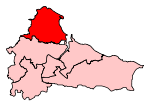 | ||
| Middlesbrough BC | 60,764 | 8,390 | Andy McDonald‡ | Ruth Betson† | Middlesbrough Borough Council: Acklam, Ayresome, Beckfield, Beechwood, Brookfield, Clairville, Gresham, Kader, Linthorpe, Middlehaven, North Ormesby and Brambles Farm, Pallister, Park, Thorntree, University. | 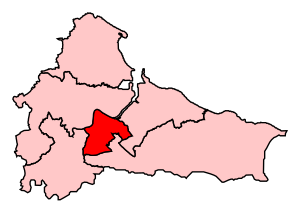 | ||
| Middlesbrough South and East Cleveland CC | 72,348 | 11,626 | Simon Clarke† | Lauren Dingsdale‡ | Middlesbrough Borough Council: Coulby Newham, Hemlington, Ladgate, Marton, Marton West, Nunthorpe, Park End, Stainton and Thornton. Redcar and Cleveland Borough Council: Brotton, Guisborough, Hutton, Lockwood, Loftus, Saltburn, Skelton, Westworth. |  | ||
| Redcar BC | 66,864 | 3,527 | Jacob Young† | Anna Turley‡ | Redcar and Cleveland Borough Council: Coatham, Dormanstown, Eston, Grangetown, Kirkleatham, Longbeck, Newcomen, Normanby, Ormesby, St Germain’s, South Bank, Teesville, West Dyke, Zetland. | 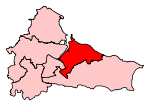 | ||
| Stockton North BC | 66,649 | 1,027 | Alex Cunningham‡ | Steven Jacksonr† | Stockton-on-Tees Borough Council: Billingham Central, Billingham East, Billingham North, Billingham South, Billingham West, Hardwick, Newtown, Northern Parishes, Norton North, Norton South, Norton West, Roseworth, Stockton Town Centre, Western Parishes. | 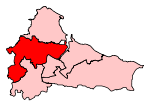 | ||
| Stockton South BC | 76,870 | 5,260 | Matt Vickers† | Paul Williams‡ | Stockton-on-Tees Borough Council: Bishopsgarth and Elm Tree, Eaglescliffe, Fairfield, Grangefield, Hartburn, Ingleby Barwick East, Ingleby Barwick West, Mandale and Victoria, Parkfield and Oxbridge, Stainsby Hill, Village, Yarm. |  | ||
Boundary changes
The Boundary Commission for England proposed retaining these 6 constituencies, with changes to realign constituency boundaries with the boundaries of current local government wards, and to reduce the electoral disparity between constituencies. These changes were implemented at the 2010 United Kingdom general election.
| Name | Pre-2010 Boundaries | Post-2010 Boundaries |
|---|---|---|
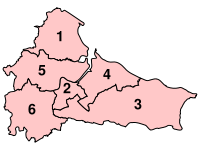 Parliamentary constituencies in Cleveland |
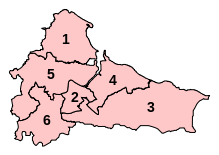 Proposed Parliamentary constituencies in Cleveland | |
Proposed boundary changes
The Boundary Commission for England submitted their final proposals in respect of the Sixth Periodic Review of Westminster Constituencies (the 2018 review) in September 2018. Although the proposals were immediately laid before Parliament they were not brought forward by the Government for approval. Accordingly, they did not come into effect for the 2019 election which took place on 12 December 2019, and which was contested using the constituency boundaries in place since 2010.
Under the terms of the Parliamentary Voting System and Constituencies Act 2011, the Sixth Review was based on reducing the total number of MPs from 650 to 600 and a strict electoral parity requirement that the electorate of all constituencies should be within a range of 5% either side of the electoral quota.
On 24 March 2020, the Minister of State for the Cabinet Office, Chloe Smith, issued a written statement to Parliament setting out the Government's thinking with regard to parliamentary boundaries. They propose to bring forward primary legislation to remove the statutory obligation to implement the 2018 Boundary Review recommendations, as well as set the framework for future boundary reviews in time for the next review which is due to begin in early 2021 and report no later than October 2023. It is proposed that the number of constituencies now remains at the current level of 650, rather than being reduced to 600, while retaining the requirement that the electorate should be no more than +/- 5% from the electoral quota.[5]
Results history
Primary data source: House of Commons research briefing - General election results from 1918 to 2019[6]
2019
The number of votes cast for each political party who fielded candidates in constituencies comprising Cleveland in the 2019 general election were as follows:
| Party | Votes | % | Change from 2017 | Seats | Change from 2017 |
|---|---|---|---|---|---|
| Conservative | 112,092 | 43.5% | 3 | ||
| Labour | 104,691 | 40.6% | 3 | ||
| Liberal Democrats | 10,452 | 4.1% | 0 | 0 | |
| Greens | 2,257 | 0.9% | 0 | 0 | |
| Brexit | 19,837 | 7.7% | new | 0 | 0 |
| Others | 8,465 | 3.2% | 0 | 0 | |
| Total | 257,794 | 100.0 | 6 |
Percentage votes
| Election year | 1983 | 1987 | 1992 | 1997 | 2001 | 2005 | 2010 | 2015 | 2017 | 2019 |
|---|---|---|---|---|---|---|---|---|---|---|
| Conservative | 35.8 | 33.8 | 37.1 | 25.2 | 26.3 | 23.0 | 27.7 | 29.0 | 38.8 | 43.5 |
| Labour | 37.9 | 44.7 | 50.0 | 62.4 | 59.5 | 51.9 | 39.9 | 43.3 | 53.8 | 40.6 |
| Liberal Democrat1 | 26.2 | 20.9 | 12.8 | 9.8 | 12.4 | 19.3 | 21.4 | 5.3 | 2.6 | 4.1 |
| Green Party | - | * | * | * | * | * | - | 2.3 | 0.4 | 0.9 |
| UKIP | - | - | - | * | * | * | 4.3 | 17.9 | 4.2 | * |
| Brexit Party | - | - | - | - | - | - | - | - | - | 7.7 |
| Other | 0.1 | 0.6 | 0.2 | 2.6 | 1.8 | 5.8 | 6.7 | 2.2 | 0.2 | 3.2 |
11983 & 1987 - SDP-Liberal Alliance
* Included in Other
Seats
| Election year | 1983 | 1987 | 1992 | 1997 | 2001 | 2005 | 2010 | 2015 | 2017 | 2019 |
|---|---|---|---|---|---|---|---|---|---|---|
| Conservative | 1 | 2 | 2 | 0 | 0 | 0 | 1 | 1 | 1 | 3 |
| Labour | 4 | 4 | 4 | 6 | 6 | 6 | 4 | 5 | 5 | 3 |
| Liberal Democrat1 | 1 | 0 | 0 | 0 | 0 | 0 | 1 | 0 | 0 | 0 |
| Total | 6 | 6 | 6 | 6 | 6 | 6 | 6 | 6 | 6 | 6 |
11983 & 1987 - SDP-Liberal Alliance
Maps
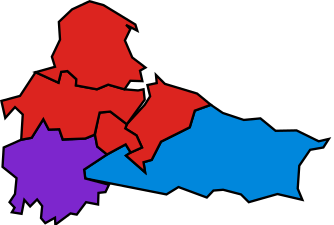 1983
1983 1987
1987 1992
1992 1997
1997 2001
2001 2005
2005 2010
2010 2015
2015 2017
2017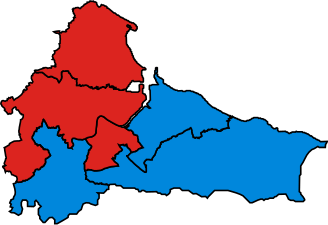 2019
2019
Historical representation by party
Conservative Labour Liberal Democrats Social Democratic
| Constituency | 1983 | 1987 | 91 | 1992 | 1997 | 2001 | 04 | 2005 | 2010 | 12 | 2015 | 2017 | 2019 |
|---|---|---|---|---|---|---|---|---|---|---|---|---|---|
| Hartlepool | Leadbitter | Mandelson | Wright | Hill | |||||||||
| Middlesbrough | Bell | McDonald | |||||||||||
| Stockton North | Cook | Cunningham | |||||||||||
| Redcar | Tinn | Mowlam | Baird | Swales | Turley | Young | |||||||
| Langbaurgh / Middlesbrough South and East Cleveland (1997) | Holt | Kumar | Bates | Kumar | Blenkinsop | Clarke | |||||||
| Stockton South | Wrigglesworth | Devlin | Taylor | Wharton | Williams | Vickers | |||||||
Notes
- BC denotes borough constituency, CC denotes county constituency.
- The majority is the number of votes the winning candidate receives more than their nearest rival.
References
- Baker, Carl; Uberoi, Elise; Cracknell, Richard (28 January 2020). "General Election 2019: full results and analysis". Commons Library. Retrieved 23 April 2020.
- "Constituencies A-Z - Election 2019". BBC News. Retrieved 23 April 2020.
- "The Parliamentary Constituencies (England) Order 2007, page 4". Office of Public Sector Information. Crown copyright. 13 June 2007. Retrieved 7 November 2009.
- Boundary Commission for England pp. 1004–1007
- "Update: Strengthening Democracy:Written statement - HCWS183". UK Parliament. Retrieved 20 April 2020.
- Watson, Christopher; Uberoi, Elise; Loft, Philip (17 April 2020). "General election results from 1918 to 2019". Retrieved 3 May 2020.